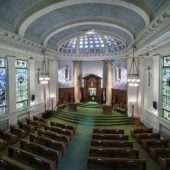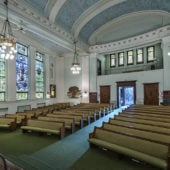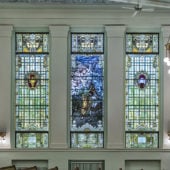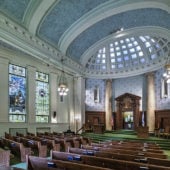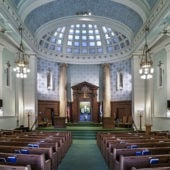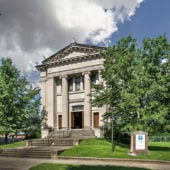The oldest active synagogue building in Indiana.
The community of Jewish Germans began in 1849, as The Terre Haute Israelite Burial Society. It officially changed to a congregation in 1858, when it became the Terre Haute Zions Gemeinde (German for community or congregation(. The synagogue, in rented space, became “Temple Israel” in 1889. In 1911, the congregation moved into its new building with “Temple Israel” literally carved in stone above the synagogue’s doors.
The Orthodox Synagogue, B’nai Abraham, merged with the Reform Temple Israel in 1935, and the two congregations became United Hebrew Congregation. This is the first lasting merger between Reform and Orthodox in the United States. After the Orthodox synagogue was sold in the 1960s, the Temple Israel building became the sole synagogue in the Wabash Valley. To respect the merger of both synagogues, the Temple Israel building is now known as United Hebrew Congregation.
The New York-Chicago architect Simon Eisendrath chose a neoclassical design for the temple. Famous for its symmetry, the neoclassical style symbolizes justice and democracy. The exterior’s distinctive Ionic columns, the sanctuary’s barrel-vaulted ceiling and half-dome skylight, and the hand-carved ark are symbolic of the outward strength and inner beauty of the Jewish culture.
The Art Nouveau stained-glass windows, typical of the early twentieth century, depict Moses receiving the Ten Commandments and The Binding of Isaac. These human images demonstrate the early liberal leanings of the Jewish Reform Movement.
As a 105 year-old synagogue, continuously cared for by the Terre Haute Jewish Community, the Temple Israel building is historic. It is the oldest active synagogue in Indiana.
The foregoing is presented by courtesy of United Hebrew Congregation of Terre Haute.



